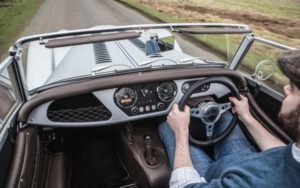Morgan Plus 4: making them like they used to (www.telegraph.co.uk)
It’s hard to believe that the car I’m driving was only built a few months ago.
To the casual observer I could be in a tidy classic from the Fifties, its round headlamps piercing the soggy mist and the pop-pop of the exhaust crackling around the valley like rifle fire. It feels like a post-war roadster on the inside, too, with chrome dials on a leather dash beneath a narrow, near-vertical windscreen.
The Morgan Plus 4 is a relic, left over from a mass extinction that occurred in the second half of the 20th century. It’s barely changed since its launch at the Earl’s Court Motor Show in 1950, apart from power train upgrades commensurate with prevailing availability. Morgan doesn’t build its own engines or gearboxes, so my Plus 4 has a 2.0-litre, four-cylinder Ford engine coupled to Mazda’s five-speed manual gearbox that’s such a delight in the MX-5.
That’s not to say it’s been modernized. The safety equipment starts and stops with seat belts, and the cabin is on the invasive side of snug. You don’t steer the Plus 4 so much as turn the wheel and observe the effect. It still has leaf spring rear suspension, now more commonly found on light goods vehicles, and sliding pillar front suspension, now more commonly found on… well, nothing really. No cars, anyway.
